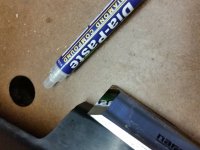ear3
Member
I decided to add some higher grits to the dmt sharpening stones I started using last month. Went with a shapton 8000 grit glass stone, and then the 1 micron Dia paste, which i've put on a piece of hard maple. Results are spectacular, as you can see from the picture. As I joked with another FOG member, I'm going to have to change my previous sharpness testing method from slicing the skin in my fingertips -- after just the shapton, I drew blood without even trying.
So two questions.
After the final hone with the diamond paste, should I still lap the back with a few strokes, and if so, what grit? I lapped on the 4000 grit dmt Dia sharp stone, because I was worried about getting the diamond compound mixed in on the ceramic shapton, but maybe that's not an issue? (Back of chisel already lapped flat up to 4000).
Second, the diamond paste instructions say you can store the paste coveted board in a ziplock and reuse. How many uses can you get from the board before having to recharge?
So two questions.
After the final hone with the diamond paste, should I still lap the back with a few strokes, and if so, what grit? I lapped on the 4000 grit dmt Dia sharp stone, because I was worried about getting the diamond compound mixed in on the ceramic shapton, but maybe that's not an issue? (Back of chisel already lapped flat up to 4000).
Second, the diamond paste instructions say you can store the paste coveted board in a ziplock and reuse. How many uses can you get from the board before having to recharge?

